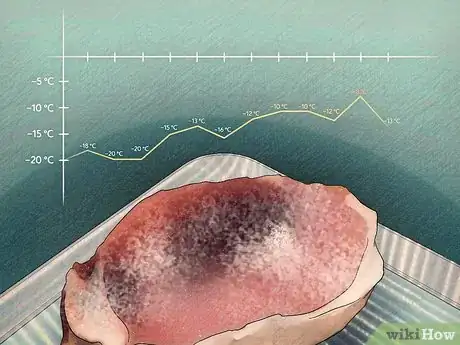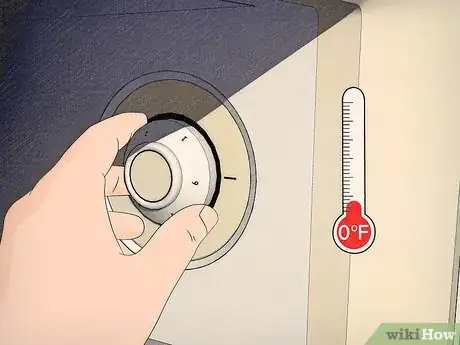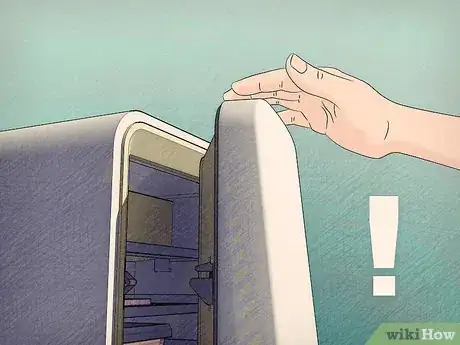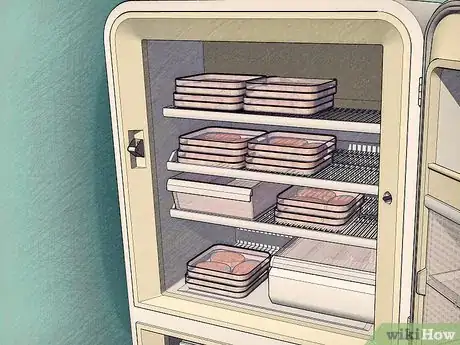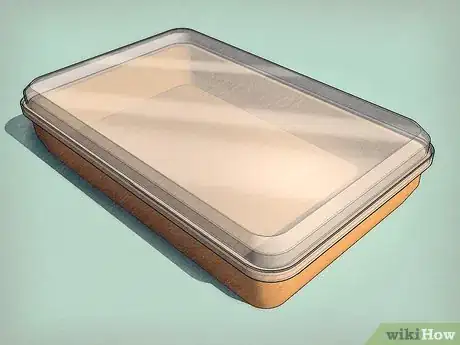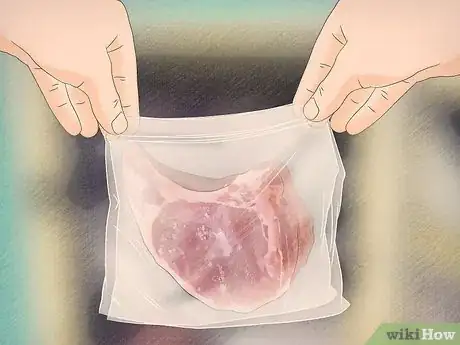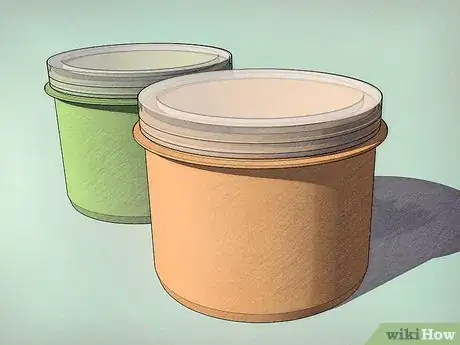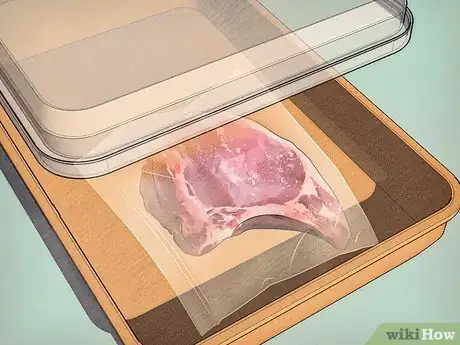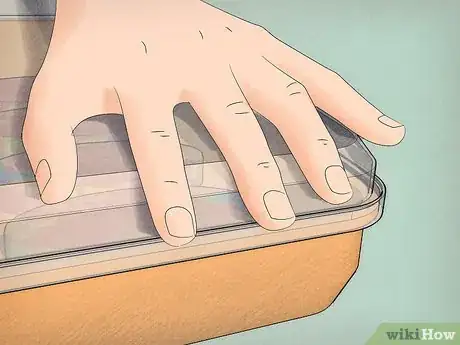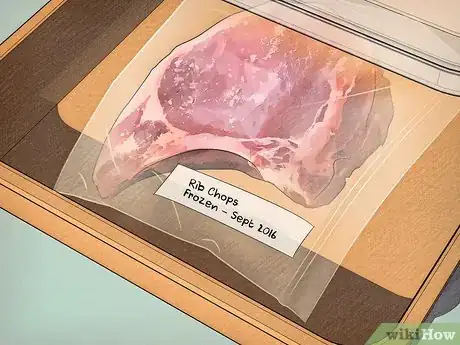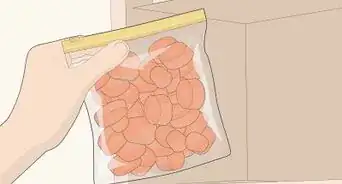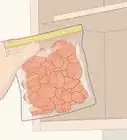This article was co-authored by wikiHow Staff. Our trained team of editors and researchers validate articles for accuracy and comprehensiveness. wikiHow's Content Management Team carefully monitors the work from our editorial staff to ensure that each article is backed by trusted research and meets our high quality standards.
wikiHow marks an article as reader-approved once it receives enough positive feedback. In this case, 90% of readers who voted found the article helpful, earning it our reader-approved status.
This article has been viewed 362,897 times.
Learn more...
Buying foods in bulk when it’s on sale or stocking up on fresh produce when it’s in season is a great way to save money, and make sure you have plenty of food for the week. And when you end up with too much, or want to put some away for later, freezing is an excellent way to preserve food for longer than its natural shelf life. But freezing food to preserve it is only a viable option if you take steps to protect the food from freezer burn, which can damage the look, taste, and smell of food.
Steps
Maintaining the Right Environment in the Freezer
-
1Know what causes freezer burn. Freezer burn occurs when food in the freezer dries out. Moisture can evaporate from food when the temperature of the freezer is inconsistent. For instance, if you're always opening and closing the freezer, the temperature will fluctuate, and this will cause water to evaporate from the food.
- When too much moisture evaporates from the food, the tissue dries out, and that’s what freezer burn is.[1]
- The main causes of temperature fluctuations in the freezer include opening the door often, freezing too much food at once, freezing food that hasn’t been pre-chilled, and not setting the freezer to the right temperature.
-
2Set the temperature. As the name suggests, a freezer is meant to be at or below freezing temperature. If the freezer is warmer than that, it will encourage the moisture to evaporate from food faster, and this will lead to freezer burn.
- For freezers with basic dials, set your freezer to Cold or Low. For freezers with temperature gauges, set it to 0ºF (-18ºC).[2]
Advertisement -
3Chill foods before freezing. There are many things that can cause the temperature of your freezer to fluctuate, and putting in warm or room temperature food is one of those ways. If you put hot food in the freezer, it will increase the surrounding temperature, and this will cause evaporation and moisture loss in nearby foods.
- Before transferring food or leftovers to the freezer, chill them in the fridge for one to two hours prior in order to bring down the temperature.[3]
-
4Freeze food in small batches. Similarly, putting too much thawed food in the freezer at once can also increase the temperature of the freezer, and the moisture loss this causes in surrounding food will lead to freezer burn.
- To help maintain the temperature in your freezer, only freeze up to three pounds (1.4 kg) of food per cubic foot of capacity at a time.[4]
- This doesn’t apply for foods that are already frozen, because the freezer doesn’t have to work to equalize the temperature.
-
5Open the door as little as possible. Every time you open the door to the freezer, cold air rushes out and is replaced with warm air from the room. This not only wastes energy because the freezer has to work harder to normalize the temperature again, but it also leads to evaporation and moisture loss in the food.[5]
- Never leave the door of the freezer open for longer than necessary. Organize your freezer to make it easier to find food.
-
6Keep your freezer full. Ideally, you want to keep your freezer about 75 percent full at all times. This is because cold food will help keep other food cold, the same way that an icepack keeps food chilled in a cooler.[6]
- It’s important that you don’t overstuff your freezer, however, as this will restrict ventilation, meaning the temperature inside the freezer will be inconsistent.
-
7Encourage air flow. Even with your freezer full, you want to leave headroom above the food and space below so air can circulate evenly. Leave about four inches (10 cm) of headspace at the top of the freezer, and a couple inches on the bottom.
- If your freezer doesn’t have a shelf or rack for the bottom, consider installing one that will allow cold air to easily circulate throughout the freezer.
Minimizing Food’s Exposure to Air
-
1Use quality, freezer-safe containers. One of the main culprits that causes freezer burn is the air, so keeping food airtight when it’s in the freezer can help prevent freezer burn. One of the easiest ways to do this is to use containers that are meant for the freezer, because they tend to be thicker, more durable, and more airtight.
- The best materials for housing frozen food are plastic containers, glass containers or jars, or freezer bags. Jars are great for liquid foods, and bags and containers are ideal for solids.
- Plastic wrap, waxed paper, and aluminum foil should only be used in conjunction with a proper freezer-safe container or bag.
- Use glass and plastic containers with airtight lids.
- For bags, choose ones that are specifically designed to be freezer bags. These tend to be made of thicker plastic and can be sealed to keep air out.
- Avoid plastic wrap and Styrofoam food containers, as these aren't airtight.[7]
-
2Double-wrap foods. Another way to keep food away from exposure to the air is to double wrap it for extra protection. This is especially important for items that will be stored long-term, or that have delicate flavors that would be ruined by freezer burn.
- You can double-wrap non-liquid foods like bread, baked goods, leftovers, and more. Wrap the food tightly in one to two layers of aluminum foil, waxed paper, or plastic wrap. Then, transfer the wrapped food to a sealable freezer bag.[8]
- Alternatively, you can also place foods (including solids) into a freezer bag and then wrap the freezer bag with aluminum foil or plastic wrap.
-
3Use containers of the right size for liquids. Even an airtight container will expose food to air if the container isn't full. For that reason, choose the smallest container possible to store liquid foods such as soups, sauces, and stews.[9]
- Ideally, you want the food to fill the jar completely, minus about a half-inch inches (1.3 cm) for headroom.
- Headroom is required in the container because liquids expand when they freeze, and if you don’t leave extra space, they will break the container or pop the lid.
-
4Cover the surface of food. Leaving headroom in a container is sometimes necessary, but you can protect foods, liquids, and leftovers from air by covering the surface before putting on the lid.[10]
- Place your food into the container, leaving headroom if necessary. Then, cut a piece of foil, plastic, or wax paper that’s large enough to cover the surface of the food, plus a few extra inches (several centimeters).
- Cover the surface of the food with the paper, plastic, or foil. Press the excess up the sides of the container and over the rim.
- Affix an airtight lid on the container, trapping the cover in place.
-
5Push out excess air from freezer bags. When you store food in freezer bags, it’s important to push or suck out all the air from the bag before freezing your food. To remove as much air as possible, use vacuum freezer bags that allow you to use suction to suck all the air out of the bag. You can also remove air manually if you don’t have a vacuum system:
- Place your food in the bottom of the freezer bag, and then fold the food and bag over on itself, working toward the opening.
- When you get to the top of the bag, seal the bag most of the way.
- Insert a straw into the bag and suck out as much air as you can. Remove the straw and quickly seal the bag the rest of the way.[11]
-
6Seal containers and bags properly. Going through all the effort to protect your food from air is a waste if you don’t properly seal the container the food is in. Improperly sealed containers will let air leak in, and this will lead to freezer burn.[12]
- Make sure you have the right lid for your jar or container. For a press-on lid, make sure the lid is completely sealed to the container. For a screw-on lid, make sure the lid is on properly and tight.
- For a freezer bag, make sure the bag is fully closed along the entire length of the seal.
-
7Keep foods frozen for as little time as possible. One of the biggest keys to preventing freezer burn is making sure your foods don’t stay in the freezer long enough to develop it. This will minimize the food’s exposure to air, and ensure the food is eaten when it’s still in its prime.
- You can generally keep foods frozen for about nine months. After that, there's a good chance freezer burn will occur, no matter how well the food is sealed.
- Rotate the food in your freezer when you add new stuff. This ensures the older food gets eaten first.[13]
- It’s also a good idea to date the food you freeze, and that way you know when it should come out of the freezer.
Community Q&A
-
QuestionWhen food has freezer burn is there anything different that needs to be done when cooking it?
 Oliver ViploveCommunity AnswerNo, no need of any extra effort for cooking freezer burned raw material, all you have to do is to remove the freezer burned portion. Freezer burn does not affect the safety of consuming the food.
Oliver ViploveCommunity AnswerNo, no need of any extra effort for cooking freezer burned raw material, all you have to do is to remove the freezer burned portion. Freezer burn does not affect the safety of consuming the food. -
QuestionMy ice cream always has freezer burn. Why does it never have a soft consistency?
 Community AnswerYou are probably buying too much ice cream; you should buy only what you can eat in a week. Freezer burn happens because there is too much air in contact with your food. Place an open bag of rice in the carton to fill up the excess space and reduce the air that is in contact with the ice cream. This will also help reduce excess humidity on the ice cream from freezing.
Community AnswerYou are probably buying too much ice cream; you should buy only what you can eat in a week. Freezer burn happens because there is too much air in contact with your food. Place an open bag of rice in the carton to fill up the excess space and reduce the air that is in contact with the ice cream. This will also help reduce excess humidity on the ice cream from freezing.
References
- ↑ http://www.thekitchn.com/food-science-what-is-freezer-b-62927
- ↑ https://www.thebalance.com/how-to-prevent-freezer-burn-1388419
- ↑ http://dontwastethecrumbs.com/2012/10/freezer-burn-gross-yet-safe-and-10-tips-for-prevention/
- ↑ http://www.moneycrashers.com/prevent-freezer-burn-causes/
- ↑ http://happymoneysaver.com/avoid-freezer-burn/
- ↑ https://www.thebalance.com/how-to-prevent-freezer-burn-1388419
- ↑ http://www.favoritefreezerfoods.com/freezer-burn.html
- ↑ http://www.thekitchn.com/food-science-what-is-freezer-b-62927
- ↑ http://www.moneycrashers.com/prevent-freezer-burn-causes/
About This Article
To prevent freezer burn, minimize food’s exposure to air by using quality, freezer-safe containers. If you’re wrapping foods in foil, plastic wrap, or waxed paper, make sure to double wrap or put the wrapped food in a freezer bag. Also, make sure to push out any excess air from freezer bags before sealing them. For liquids, use the smallest container possible otherwise the food will be exposed to air. To learn how to maintain the right environment in the freezer, keep reading!
